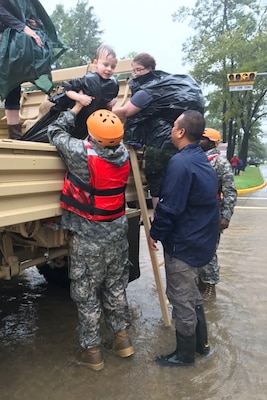By Army Sgt. 1st Class Jon Soucy National Guard Bureau
ARLINGTON, Va., Aug. 30, 2017 — The National Guard response
to Hurricane Harvey will be a long-term, sustained effort, a senior National
Guard official said today, adding that up 30,000 Guard members stand ready to
assist with those efforts if needed.
"We are leaning as far forward as we possibly can to
ensure that military assets are postured to support the needs of Texas and,
potentially, Louisiana," said Air Force Maj. Gen. James C. Witham, the
director of domestic operations at the National Guard Bureau here.
More than 4,300 Guard members were on duty in Texas as of
this morning, primarily assisting local authorities with search and rescue
operations. Texas Gov. Greg Abbott has called up the entire Texas National
Guard, numbering around 12,000 soldiers and airmen, who may be brought on duty
gradually over the next few days as needed, Witham said.
As of yesterday afternoon, Guard members had taken part in
more than 3,500 rescues of those affected by the storm, mostly in the Houston
area.
"Most [rescues] have been by some type of boat, but
these also include almost 300 hoist rescues [by helicopter], which are very
technically difficult," Witham said, adding that weather conditions
initially prevented helicopter crews from flying.
Helicopters Support Efforts
Some 30 helicopters are now in use by Guard aircrews, the
general said, and additional helicopter assets have been requested through the
Emergency Management Assistance Compact, which allows Guard elements from one
state to assist in other states in emergencies.
Aircrews are supporting not only airborne search and rescue
efforts with hoist capacity, but also medical evacuation capacity as required,
Witham said.
Guard elements from 10 states are supporting Hurricane
Harvey response operations, with some coming from as far away as Alaska.
"As you talk response and recovery, our response is
very sustained," Witham said, adding that the storm's unprecedented amount
of rainfall has made for a different sort of hurricane response.
"When the Guard responds to hurricane-type events,
normally we talk about that first 72 to 96 hours for the lifesaving and
life-sustainment that takes place. Then, we're into the recovery effort,"
he explained. "Due to the nature of this storm as it spun across southeast
Texas for days and dumped historic levels of rainfall, our response has been very
different than what we've looked at before."
Second Landfall in Louisiana
Meanwhile, in Louisiana, the storm made its second landfall
early today as it continues to move eastward. Soldiers and airmen with the
Louisiana National Guard pre-positioned equipment and supplies in advance of
the storm, Witham said. About 400 soldiers and airmen are currently on duty, he
added.
But Louisiana Guard members were busy in other ways before
the storm made landfall.
On Aug. 28, soldiers with the Louisiana Army National
Guard's 3rd Battalion, 156th Infantry Regiment rescued more than 100 people in
the Lake Charles area, roughly 35 miles east of the Texas border. Unit members
assisted local first responders with the rescues, and are anticipating
additional rescue efforts in the coming days.
"In the next 24 hours, I think they predicted anywhere
from 5 to 10 inches of rain," said Army Maj. Aaron Duplechin, commander of
the unit. "So it just kind of depends on when those bands hit and
where."
Witham said the response in Louisiana was no different from
response efforts in Texas, and that soldiers and airmen continue to respond as
needed.
"We are very proud of the Texas Guard [members] who
have responded at this point," he said. "The soldiers and airmen have
been working around the clock … to alleviate the pain and suffering that has
been experienced by the citizens in Houston and southeast Texas."

No comments:
Post a Comment